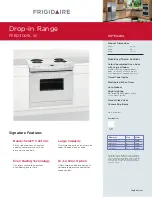
60
Setting the oven
Here you can find out how to set the oven.
Types of heating and temperature
Example in the picture: 190 °C,
<
3D hot air.
1.Use the function selector to select the required type of heating.
2.Use the temperature selector to set the temperature.
The oven heats up.
Switching off the oven
Turn the function selector to the off position.
Changing the settings
The type of heating and temperature can be changed as required.
Care and cleaning
With attentive care and cleaning, your hob and oven will retain its
looks and remain in good working order for a long time. We will
explain here how you should care for and clean them correctly.
Notes
■
Slight differences in the colours on the front of the oven are
caused by the use of different materials, such as glass, plastic
and metal.
■
Shadows on the door panel which look like streaks, are caused
by reflections made by the oven light.
■
Enamel is baked on at very high temperatures. This can cause
some slight colour variations. This is normal and does not affect
operation. The edges of thin trays cannot be completely
enamelled. As a result, these edges can be rough. This will not
impair the anti-corrosion protection.
Upper glass cover
Before opening the top cover, remove any spills with a cloth.
Use glass cleaner if possible.
For cleaning, remove the top cover. To do this, hold the cover
securely on both sides with both hands and pull it upwards.
If the cover hinges become loose, note the letters marked on
them. The hinge with the letter R must be fitted on the right, and
the hinge with the letter L must be fitted on the left.
After cleaning, re-assemble the top cover following the same
procedure in reverse order.
Only close the top cover once the burners have cooled down.
Cleaning agents
Damage to the various different surfaces caused by using the
wrong cleaning agent can be avoided by observing the following
instructions.
When cleaning the hob do not use
■
undiluted washing-up liquid or dishwasher detergent,
■
scouring pads,
■
abrasive cleaning agents such as oven cleaner or stain
remover,
■
high-pressure cleaners or steam jets.
■
Do not clean individual parts in the dishwasher.
When cleaning the oven do not use
■
sharp or abrasive cleaning agents,
■
cleaning agent with a high alcohol content,
■
scouring pads,
■
high-pressure cleaners or steam jets.
■
Do not clean individual parts in the dishwasher.
Wash new sponges thoroughly before first use.
Stainless steel fronts
Wipe with some washing-up liquid and a damp cloth. Always wipe parallel to the natural grain. Otherwise, you
may scratch the surface. Dry with a soft cloth. Remove flecks of limescale, grease, starch and albumin (e.g. egg
white) immediately. Do not use any abrasive materials, scouring sponges or rough cleaning cloths. The stain
-
less steel fronts can be polished using a special care product. Follow the manufacturer's instructions. You can
purchase special stainless steel cleaner from our after-sales service or from specialist retailers.
Enamel surfaces and
lacquered surfaces
Clean with some washing-up liquid and a damp cloth. Dry with a soft cloth.













































